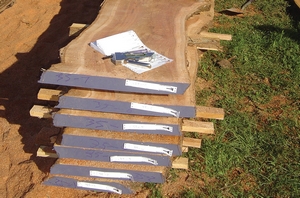Working with Maori
 Success for Māori is also success for New Zealand.
Success for Māori is also success for New Zealand.As substantial land holders of commercially forested land, Māori are a critical part of the New Zealand forestry story and will continue to become even more so as Treaty settlements return more land and forests to iwi. The future of New Zealand’s forest industry, and the types of products the industry will be producing in 10 or 20 years’ time, will increasingly be influenced by Māori as either active participants in commercial forestry or by the decisions they make on how their land will be used.
In 2014, Scion revised its Māori plan in conjunction with our Ngā Rangatira. We set our leading indicators of success to be:
- Scion and Māori are actively partnering and jointly investing to support Māori economic development through their forestry assets.
- Māori and Scion staff are working in each other’s organisations and learning from each other.
- There is increased investment into Scion research programmes that directly support Māori aspirations.
Scion’s programmes in partnership with iwi are continuing to grow with a greater involvement between Scion staff and our iwi partners. Some examples are listed below.
A hui was held in collaboration with Te Puni Kokiri and the Forest Growers Levy Trust, where research and development being co-funded by the levy was shared with Māori trusts and incorporations that are involved, or aspiring to be involved, in forestry. In return, those groups shared their experiences and plans for forestry, with all parties able to identify areas of mutual interest and future focus. The hui provided valuable insights on what is important to Māori in research programmes in New Zealand. We plan to continue hui in the regions in 2015-16 to build direct links with trusts and incorporations, and transfer forestry research findings.
Iwi are investing more in forestry programmes. For example, two iwi clusters are developing their own forestry development and management strategies; and the Toitu Te Waonui initiative is looking at ways to increase forestry on currently under-utilised land with the help of third party investors. Direct investment by Māori was also made into a new national programme to realise greater value from eucalypt species, Douglas-fir and cypresses, and into evolving programmes in indigenous forestry and products. Special focus is being placed on tōtara and manuka (and their product value chains), and the commercial propagation of these and other indigenous species.
Crown research institutes are collectively partnering with Māori. Examples include: a partnership with Maniopoto Māori Trust Board to support land-based economic development options for Maniopoto; and with the Centre of Integrated Biowaste Research, an ESR-led programme, to engage the community over re-use options for biosolids. In June 2015, the CRIs in collaboration with Māori, hosted the Te Ara Pūtaiao hui to help re-connect iwi and hapu with science and technology.
Scion entered into a partnership with local Te Kura o Te Whakarewarewa primary school to introduce Māori children to science. At the same time, the children are challenging Scion’s scientists to understand their world view. Our scientists and the students are working together to monitor the health of a local stream. The programme is now being extended by the school to include other science areas from Scion.
Helping to protect tāonga species and support community resilience is a special focus for Scion. During 2014-15, we continued to help East Coast Māori protect the endangered ngutukaka species, developed forest strategies to build community resilience in the fragile environment of the Waiapu Catchment area, and worked with Northland Māori through the Tangata Whenua Rōpu of Te Tai Tokerau to help find solutions to kauri dieback disease.
